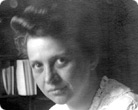America's first female cabinet member, Frances Perkins served as secretary of labor from 1933 until 1945, longer than any other secretary. Perkins was a committed advocate for working people, establishing the Fair Labor Standards Act and the Labor Standards Bureau. She also strengthened labor-law enforcement and was the primary architect of Social Security.
Born Fannie Coralie Perkins in 1882, Perkins legally changed her name to Frances when she left her upper-middle-class home in Massachusetts. She graduated from Mount Holyoke College with a degree in chemistry and physics in 1902. There, as part of her coursework, she visited local factories, thus beginning a lifelong interest in the problems of workers. She moved to Chicago in 1904 to take a position teaching science at a women's college and while there also became involved as a volunteer and worker at Hull House, the nation's leading settlement house. By 1909, she had given up teaching science and moved to New York to study at Columbia University, where she earned a master's degree in economics and sociology. She witnessed the historic Triangle Shirtwaist Factory fire of 1911, which gave her desire for labor rights a new urgency. Perkins served as secretary for the New York City Committee on Safety, which led a successful fight to pass 36 new state labor laws, including legislation that restricted the weekly hours for women and children and provided compensation for work-related injuries.
Perkins retained her own surname when she married Paul Caldwell Wilson in 1913. Wilson, an economist in the New York Bureau of Municipal Research, was institutionalized many years for chronic mental illness. Throughout her long career, Perkins sheltered her husband and their daughter Susanna from the public eye.
An early feminist, Perkins governmental career began when she campaigned among the suffragettes for New York gubernatorial candidate Al Smith. After his election, Smith appointed her to the state industrial commission. In 1929, Governor Franklin D. Roosevelt named her the state industrial commissioner; she reduced women's work week to 48 hours and facilitated minimum-wage laws. When he gained the presidency, FDR invited her to be the country's first female cabinet secretary. As such, she led the fight against the Great Depression, playing a key role in formulating New Deal legislation. During her tenure, child labor was abolished, minimum wage and maximum-hour laws were enacted, and, through the National Labor Relations Act of 1935, workers were guaranteed the right to organize and bargain collectively. She also chaired the Committee on Economic Security, established in 1934, which recommended the nationalization of unemployment and old-age insurance. Thanks to her committed pursuit of this ideal, the Social Security Act was signed into law in 1935.
Perkins resigned her post in 1945 to head the U.S. delegation to the International Labor Organization conference, but soon returned to serve as a federal civil service commissioner until her retirement in 1952. She continued an active life of teaching and public speaking until her death in 1965, in New York City. In 1980, President Carter renamed the Department of Labor building in her honor. Frances Perkins is the author of numerous studies and speeches, as well as two books, People at Work (1934) and The Roosevelt I Knew (1946). Her extensive oral-history interviews were recorded in 1955, 1957, 1960, and 1961.















